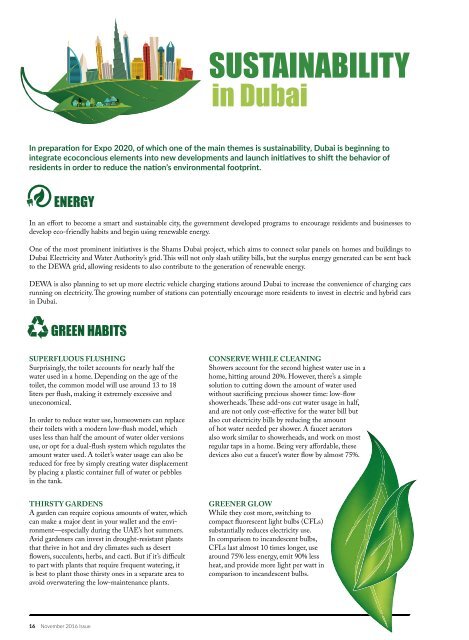DRIVEN
driven-properties-magazine-november-2016
driven-properties-magazine-november-2016
Create successful ePaper yourself
Turn your PDF publications into a flip-book with our unique Google optimized e-Paper software.
SUSTAINABILITY<br />
in Dubai<br />
In preparation for Expo 2020, of which one of the main themes is sustainability, Dubai is beginning to<br />
integrate ecoconcious elements into new developments and launch initiatives to shift the behavior of<br />
residents in order to reduce the nation’s environmental footprint.<br />
ENERGY<br />
In an effort to become a smart and sustainable city, the government developed programs to encourage residents and businesses to<br />
develop eco-friendly habits and begin using renewable energy.<br />
One of the most prominent initiatives is the Shams Dubai project, which aims to connect solar panels on homes and buildings to<br />
Dubai Electricity and Water Authority’s grid. This will not only slash utility bills, but the surplus energy generated can be sent back<br />
to the DEWA grid, allowing residents to also contribute to the generation of renewable energy.<br />
DEWA is also planning to set up more electric vehicle charging stations around Dubai to increase the convenience of charging cars<br />
running on electricity. The growing number of stations can potentially encourage more residents to invest in electric and hybrid cars<br />
in Dubai.<br />
GREEN HABITS<br />
SUPERFLUOUS FLUSHING<br />
Surprisingly, the toilet accounts for nearly half the<br />
water used in a home. Depending on the age of the<br />
toilet, the common model will use around 13 to 18<br />
liters per flush, making it extremely excessive and<br />
uneconomical.<br />
In order to reduce water use, homeowners can replace<br />
their toilets with a modern low-flush model, which<br />
uses less than half the amount of water older versions<br />
use, or opt for a dual-flush system which regulates the<br />
amount water used. A toilet’s water usage can also be<br />
reduced for free by simply creating water displacement<br />
by placing a plastic container full of water or pebbles<br />
in the tank.<br />
CONSERVE WHILE CLEANING<br />
Showers account for the second highest water use in a<br />
home, hitting around 20%. However, there’s a simple<br />
solution to cutting down the amount of water used<br />
without sacrificing precious shower time: low-flow<br />
showerheads. These add-ons cut water usage in half,<br />
and are not only cost-effective for the water bill but<br />
also cut electricity bills by reducing the amount<br />
of hot water needed per shower. A faucet aerators<br />
also work similar to showerheads, and work on most<br />
regular taps in a home. Being very affordable, these<br />
devices also cut a faucet’s water flow by almost 75%.<br />
THIRSTY GARDENS<br />
A garden can require copious amounts of water, which<br />
can make a major dent in your wallet and the environment—especially<br />
during the UAE’s hot summers.<br />
Avid gardeners can invest in drought-resistant plants<br />
that thrive in hot and dry climates such as desert<br />
flowers, succulents, herbs, and cacti. But if it’s difficult<br />
to part with plants that require frequent watering, it<br />
is best to plant those thirsty ones in a separate area to<br />
avoid overwatering the low-maintenance plants.<br />
GREENER GLOW<br />
While they cost more, switching to<br />
compact fluorescent light bulbs (CFLs)<br />
substantially reduces electricity use.<br />
In comparison to incandescent bulbs,<br />
CFLs last almost 10 times longer, use<br />
around 75% less energy, emit 90% less<br />
heat, and provide more light per watt in<br />
comparison to incandescent bulbs.<br />
16<br />
November 2016 Issue


